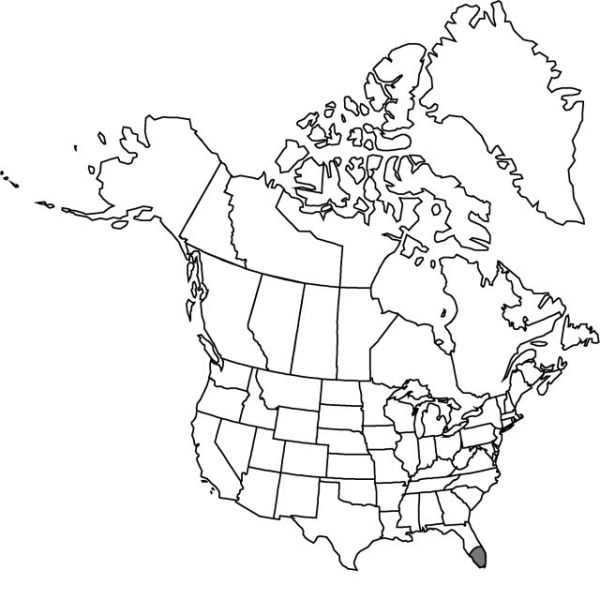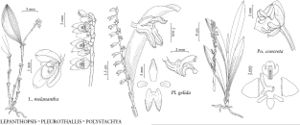Difference between revisions of "Polystachya concreta"
in R. A. Howard, Fl. Less. Antill. 1: 178. 1974.
FNA>Volume Importer |
imported>Volume Importer |
||
| (3 intermediate revisions by 2 users not shown) | |||
| Line 8: | Line 8: | ||
}} | }} | ||
|common_names=Yellow spike orchid | |common_names=Yellow spike orchid | ||
| + | |special_status={{Treatment/ID/Special_status | ||
| + | |code=F | ||
| + | |label=Illustrated | ||
| + | }} | ||
|basionyms={{Treatment/ID/Basionym | |basionyms={{Treatment/ID/Basionym | ||
|name=Epidendrum concretum | |name=Epidendrum concretum | ||
|authority=Jacquin | |authority=Jacquin | ||
| + | |rank=species | ||
|publication_title=Enum. Syst. Pl., | |publication_title=Enum. Syst. Pl., | ||
|publication_place=30. 1760 | |publication_place=30. 1760 | ||
| Line 17: | Line 22: | ||
|name=Epidendrum minutum | |name=Epidendrum minutum | ||
|authority=Aublet | |authority=Aublet | ||
| + | |rank=species | ||
}} {{Treatment/ID/Synonym | }} {{Treatment/ID/Synonym | ||
|name=Polystachya extinctoria | |name=Polystachya extinctoria | ||
|authority=Reichenbach f. | |authority=Reichenbach f. | ||
| + | |rank=species | ||
}} {{Treatment/ID/Synonym | }} {{Treatment/ID/Synonym | ||
|name=Polystachya minuta | |name=Polystachya minuta | ||
|authority=(Aublet) Britton | |authority=(Aublet) Britton | ||
| + | |rank=species | ||
}} | }} | ||
|hierarchy=Orchidaceae;Orchidaceae subfam. Epidendroideae;Orchidaceae tribe Epidendreae;Orchidaceae (tribe Epidendreae) subtribe Polystachynae;Polystachya;Polystachya concreta | |hierarchy=Orchidaceae;Orchidaceae subfam. Epidendroideae;Orchidaceae tribe Epidendreae;Orchidaceae (tribe Epidendreae) subtribe Polystachynae;Polystachya;Polystachya concreta | ||
| Line 49: | Line 57: | ||
-->{{#Taxon: | -->{{#Taxon: | ||
name=Polystachya concreta | name=Polystachya concreta | ||
| − | |||
|authority=(Jacquin) Garay & H. R. Sweet | |authority=(Jacquin) Garay & H. R. Sweet | ||
|rank=species | |rank=species | ||
| Line 63: | Line 70: | ||
|publication title=in R. A. Howard, Fl. Less. Antill. | |publication title=in R. A. Howard, Fl. Less. Antill. | ||
|publication year=1974 | |publication year=1974 | ||
| − | |special status= | + | |special status=Illustrated |
| − | |source xml=https:// | + | |source xml=https://bitbucket.org/aafc-mbb/fna-data-curation/src/2e0870ddd59836b60bcf96646a41e87ea5a5943a/coarse_grained_fna_xml/V26/V26_1263.xml |
|subfamily=Orchidaceae subfam. Epidendroideae | |subfamily=Orchidaceae subfam. Epidendroideae | ||
|tribe=Orchidaceae tribe Epidendreae | |tribe=Orchidaceae tribe Epidendreae | ||
Latest revision as of 21:12, 5 November 2020
Plants cespitose. Roots numerous, 2–3 mm diam. Stems thickened at base, hidden by leaf sheaths, composed of several internodes, to 4 cm. Leaves 2–4; blade thin, narrowly oblong to elliptic, 3.5–20 × 1.1–3 cm, apex mostly acute. Inflorescences usually paniculate racemes, simple racemes in small plants; peduncle compressed; floral bracts spreading to reflexed, 1–2 mm. Flowers yellow or pale green with white lip; dorsal sepal ovate-elliptic, 2.5–4 × 1.5–2.5 mm; lateral sepals triangular, 2.5–5 mm; petals oblanceolate, rounded, 2–3 × 1 mm; lip 3-lobed, 3–5 mm, middle lobe quadrangular to oblong, lateral lobes falcate; disc with linear, densely farinose callus (pseudopollen); column cylindric, short; column foot 2–3 mm; pedicellate ovary to 7 mm. Capsules brown at maturity, ellipsoid, 6–12 mm.
Phenology: Flowering Aug–early Dec.
Habitat: Cypress swamps, hammocks, mangroves
Elevation: 0–20 m
Distribution

Fla., pantropical (see discussion below).
Discussion
Most plants of Polystachya concreta flower from August to December; some flower at other times of the year. In Florida, Polystachya concreta [P. flavescens (Blume) J. J. Smith] is pollinated by the halictid bee, Dialictus aff. creberrimus (G. J. Goss 1977b). The bee collects the detachable, starchy lip hairs (pseudopollen).
An extensive list of synonomy is available (G. C. K. Dunsterville and L. A. Garay [1959]–1976, vol. 3), but after discussions with Phillip Cribb (pers. comm.), we suspect that the African and Asian synonyms represent different species (see also P. J. Cribb 1984). For this reason, we have excluded them from the list, even though some of them are often used for neotropical plants. Furthermore, Polystachya concreta is not as widespread in the Neotropics as formerly believed; it is absent from Mexico and Central America (J. T. Atwood, G. Carnevali F.-C., R. L. Dressler, pers. comm.).
Cranichis luteola Swartz and Polystachya luteola (Swartz) Hooker are not legitimate names.
Selected References
None.
